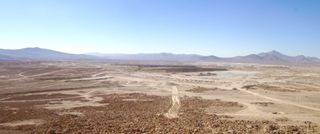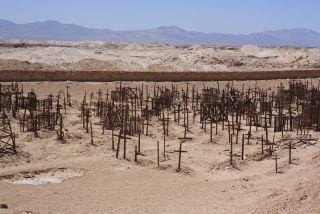Solved? Mystery of Atacama Desert's 'White Gold'

The driest, highest desert on Earth, Chile's Atacama Desert, also holds the world's richest nitrate and iodine deposits. As such, a "white gold" rush there fueled Europe's bombs in World War I and helped raise IQs once iodine deficiency was discovered.
But even after the nitrate mines closed in the 1930s, the source of the massive mineral drifts remained a mystery. Glowing white as they bake on the sere desert surface, the Atacama nitrates are like nothing else in the world.
"These are weird deposits that, from a geological perspective, shouldn't be there," said Martin Reich, a geochemist at the Universidad de Chile in Santiago. "Nitrogen is abundant in the Earth's atmosphere but is highly depleted in the [Earth's] crust. Therefore, the giant nitrate deposits of the Atacama Desert are one of the most extraordinary, yet enigmatic mineral occurrences on Earth," Reich told Live Science in an email interview. [Photos: The Haunting Splendor of Chile's Atacama Desert]
Now, Reich and an international group of collaborators think they've finally solved the mystery, thanks to painstaking chemical analysis of unusual trace chemicals in the nitrates. Their findings were published Jan. 10 in the journal Geology.
World's biggest 'white gold' mine
The Atacama nitrates create a giant, nearly continuous belt inland of the Chilean Coast Ranges — the mountains that mark the high desert's western boundary. The Coast Ranges, combined with a permanent high-pressure atmospheric ridge offshore of southern South America, block Pacific Ocean weather systems that might bring rain to the desert. To the east lie the Andes Mountains, the tall volcanoes that drain any incoming moisture from the Amazon.

The nitrate belt is about 435 miles (700 kilometers) long and 12 miles (20 km) wide. The minerals are either in crunchy surface deposits called caliche — crusts formed by evaporation — or found in veins in bedrock fractures.
Sign up for the Live Science daily newsletter now
Get the world’s most fascinating discoveries delivered straight to your inbox.
For decades, the simple explanation was that millions of years of evaporation concentrated the nitrates near the desert surface. The minerals were brought in as sea spray carried on fog, or as rain during short-lived climate shifts to wetter periods.
But Reich and his colleagues discovered a more complicated story. Their work relies on analysis of isotopes of iodine and chromium in the nitrates. (Isotopes are atoms of different weights.) The isotopes are like geochemical fingerprints, revealing whether the chemicals came from rainfall, seawater or another water source. [Video: Where'd That Water Come From? Check the Isotope]
It turns out that both the iodine and chromium come from an unusual source — deep, old groundwater.
"Our results show the iodine in the nitrate does not come from the atmosphere, such as ocean fog or sea spray, but is very old in age and has been leached and transported from marine sedimentary rocks," Reich said. The chromium isotopes also had a unique fingerprint — similar to chromium-bearing groundwater in the Mojave Desert — that suggests the nitrates formed from groundwater.
Saltpeter reborn
Based on these and other chemical clues, Reich and his colleagues now tie the birth of the nitrates to the rise of the Chilean mountains and its drying desert.
"The formation and preservation of these deposits were triggered by increasing aridity and the tectonic rise of the Andes," Reich said.
Here is the Atacama nitrates' new birth story:

The first step started more than 20 millions years ago, when rain and snow leached iodine and chromium from marine and volcanic rocks in the High Andes. These and other chemicals (nitrogen, sulfur) were transported westward into the future Atacama Desert basin by groundwater. Chile's climate was warmer and wetter then. Between 20 million and 10 million years ago, both the Andes Mountains and the Coast Ranges became higher and the climate shifted. Rainfall in the Atacama Desert dropped precipitously, until it was so low it was impossible to measure in the driest parts of the desert.
The elevation change, and difference between the wet Andes and dry desert, would drive groundwater to the west, the researchers think. But the Coast Ranges act as an impermeable barrier, forcing groundwater to rise and evaporate, leaving behind iodine, chromium and nitrate. At the same time, sea spray and fog also drop small amounts of nitrate and other minerals, weaving the complex chemistry found today.
Reich hopes to trace the ancient groundwater back to its source. "The 'paleo-groundwater' flow lines go through many copper deposits, so trace metal concentrations in the nitrates may be used as proxies for finding hidden ore deposits," Reich said.
Email Becky Oskin or follow her @beckyoskin. Follow us @OAPlanet, Facebook and Google+. Original article at Live Science's Our Amazing Planet.

